
Chapter 10
The Origin of Humans
You have probably seen the famous depiction of a monkey progressively turning into an upright human figure.
‘Biologists would dearly like to know how modern apes, modern humans and the various ancestral hominids have evolved from a common ancestor. Unfortunately, the fossil record is somewhat incomplete as far as the hominids are concerned, and it is all but blank for the apes. The best we can hope for is that more fossils will be found over the next few years which will fill the present gaps in the evidence.’ The author goes on to say: ‘David Pilbeam [a well-known expert in human evolution] comments wryly, “If you brought in a smart scientist from another discipline and showed him the meagre evidence we’ve got he’d surely say, ‘forget it: there isn’t enough to go on’.”—Richard E. Leakey, The Making of Mankind, Michael Joseph Limited, London, 1981, p. 43
What You Will Learn
You have probably seen the famous depiction of a monkey progressively turning into an upright human figure. But what evidence is there for this popular picture? The fossil record that is used to support human evolution has become more and more questionable as more and more fossils are found. The cautious way in which human ancestry is treated in the textbooks is evidence of the lack of consensus in the area of human evolution. What used to be direct evolutionary trees have become overlapping bars on a timeline. Most scientists believe that primates and humans all share a recent common ancestor at about 80 million years ago. This date is not based on fossils but on the similarity in DNA sequences and the assumptions surrounding the use of such “molecular clocks.” Many of the fossils of human ancestors consist of little more than fragments of bone, some of which have been exposed as frauds.
Most creationists consider Neanderthals, Cro-Magnon, and some other fossil groups as representatives of extinct people groups, not evolutionary dead ends. Interpretation of fossils from an evolutionary perspective is not compatible with the teachings of the Bible. The fact that chimpanzees and humans have similar DNA does not make them evolutionary relatives. Humans did not evolve in a series of random accidents from an apelike ancestor—they were created in the image of God. The Bible makes a clear distinction between man and the animals. Man is given the ability to fellowship with God and given dominion over the animals. Evolutionary ideas about the rise of man from apes has fueled racist attitudes and set the stage for such atrocities as the Holocaust. Humans were specially created by God and are not simply highly evolved primates.
| Evolutionary Concept | Glencoe | PH-Campbell | PH-Miller | Holt | Articles |
|---|---|---|---|---|---|
| Paleoanthropologists study human ancestry and cultures to explain the evolutionary history of humans. | 428–435 | 575–577 | 140–141 | T195, 731– 738, T731– T732 | 1:2, 10:1 |
| Humans and dinosaurs never existed on earth at the same time, contrary to popular beliefs. | — | T575 | — | T723 | 10:2 |
| All primates have a common ancestor from 80 million years ago. Gorillas, orangutans, chimps, and humans belong to the family Hominidae. | 420–421, 424, 847, 1068– 1069, 1086 | 574–575, T576 | T382, 833–835, T836, 837, T841 | 731– 732, T732, T734, 735, 813 | 3:6, 3:7, 10:1, 10:3 |
| Similarities in many primate traits mean they share a common ancestor. DNA and fossil evidence can provide the evolutionary history of primates. | 423, 427, 436–437 | 249, 302–304, 344, 574, 577 | 833, 835 | 220, 232, 732, 733, T733, 737– 738, T737, 742–743 | 3:6, 3:7, 10:1, 10:3 |
| Humans are evolved from hominids evident in the fossil record from 7 million years ago. | 367, 425, 426 | 575–576 | 434, 835–839, T838 | 733–734 | 10:1, 10:3 |
| Homo sapiens appeared in Africa 200,000 years ago based on fossil and DNA evidence. | 379, 433 | 577 | 434, 839–840, T840 | 737 | 10:1, 10:3 |
| Humans, chimps, and gorillas share an ancestor within 8 million years ago. Humans are most closely related to chimps with only a 2–5% difference in their DNA. | 428 | 304, 575 | 835 | T198, 732, T732, 735 | 3:6, 10:4, 10:5 |
| Australopithecines are the most likely ancestors of humans. “Lucy” is a fossil of Australopithecus afarensis that demonstrates upright walking and human features 3.2 million years ago. | 430–431 | 575–576 | 387, 836 | 733 | 10:1, 10:3 |
| Homo habilis and Homo erectus are extinct along the evolutionary path to Homo sapiens. The exact evolutionary path of hominids is not clear from the fossil record, but trends are clearly present. | 431, 435 | 576 | T838, 839–840 | 734–736 | 10:1, 10:3 |
| Neanderthals coexisted with modern humans and were an evolutionary dead end that left no descendants. | 434 | 577 | T836, T839, 841 | 738 | 10:1, 10:3, 10:6 |
Note: Page numbers preceded by “T” indicate items from the teacher notes found in the margins of the Teacher’s Edition.
What We Really Know about the Origin of Humans
The origin of humans is most certainly one of the most contentious points of evolutionary theory. Many people who believe in the God of the Bible accept that evolution created the animals but they still believe that humans (or at least their souls) were created by God. Such compromise positions have ultimately undermined the authority of God’s Word; Scripture is accepted for its moral value but not for its absolute truth in every area. It would seem that almost every culture on the planet has some story to explain how humans came to be. Many of these involve supernatural acts by gods. Naturalistic science, by its own definition, does not accept these supernatural events and regards them as myth. Religion and mythology are often viewed as some evolved coping mechanism to explain things that our brains have not been able to understand or directly experience. The scientific community must reject a supernatural origin based on its naturalistic/materialistic definition of science.
One of the reasons that human evolution is such a hot issue in Western culture stems from the direct conflict it has with biblical Christianity.
One of the reasons that human evolution is such a hot issue in Western culture stems from the direct conflict it has with biblical Christianity. In the creation account of Genesis 1 and 2, man is created in a position above the animals—in the very “image of God.” In evolutionary philosophy, man is a mere accident in the experiment run by time, chance, and natural laws. Man occupies no more important a position in the universe than does an asteroid floating through space. This notion runs contrary to the emotions of most people, but that may simply be arrogance due to our highly evolved brains.
Many may believe that there is a wide array of fossil evidence that clearly shows how apes have become humans. The iconic depiction of a hunched monkey gradually developing into an uprightwalking human has been viewed by most people. The problem is that much of the visuals are made up. The absence of a consistent story of evolution is obvious in the way that human ancestry is presented in the textbooks. Instead of showing a phylogenetic tree, two of the textbooks (Holt and Prentice Hall) simply show timelines representing the fossils. The Glencoe text shows a “possible” phylogenetic tree with many dashed lines (which are assumed to be questionable, even though they are not indicated as such), and one line appearing out of thin air. The cautious treatment of this topic shows the lack of consensus within the scientific community regarding the alleged ancestry of humans.

When the phrase “human evolution” is used, this is probably one of the first images to pop into people’s minds. Despite its iconic status and widespread use, it is not based on factual evidence, but on imagination.
The proposed evolutionary ancestors to humans have changed many times over the decades as new fossil evidence has been gathered. While it is not expected that theories should remain constant, the picture seems to become less and less common with the addition of new information. Many nearly identical terms are used to describe alleged human and ape ancestors. Care must be taken to distinguish between hominoids, humanoids, hominins, hominans, and hominids. The most commonly discussed term is “hominid”:
Hominid: extinct and living members of the family Hominidae, including modern humans and their ancestors.
The term hominid has a somewhat contradictory definition within and between the textbooks reviewed. Different classification schemes place the orangutans, gorillas, and chimps (these three are commonly called the “great apes”) in the family Pongidae, while other schemes place these three in the family Hominidae with humans. Depending on which scheme is used for classification, the meaning of the word changes. Whether the term includes the great apes is somewhat irrelevant in that all groups still share a supposed common ancestor. In the broader scope, all four of these groups would be referred to as hominoids. The textbooks seem to indicate that only bipedal (walking upright on two legs) primates are classified as hominids, and the figures discussing hominids include “ancestors” that are assumed to be bipedal (Homo, Australopithecus, Ardipithecus, etc.). A review of current literature seems to indicate a trend toward including all four groups in the family Hominidae, which would mean the definition would need to be modified. The term has no value in the creationist model because there are no human ancestors—apes are apes, humans are humans. This does not mean that all creationists agree on the classification of all of the fossil primates. Classification is a subjective issue, especially when dealing in the historical realm of fossils and fragments of fossils. It is important to recognize the limits of accuracy when dealing with such a topic.
Many evolutionists try to dispel the popular idea that humans evolved from monkeys. While that statement is a simplification of human evolution, evolutionists claim that there is a common ancestor for monkeys, apes, and humans. If this common ancestor didn’t look something like a monkey, what did it look like? It would be more accurate to say that humans, monkeys, and apes have a common ancestor, but the distinction is relatively minor when considering that the ancestor of all apes and monkeys must have looked something like an ape or monkey.
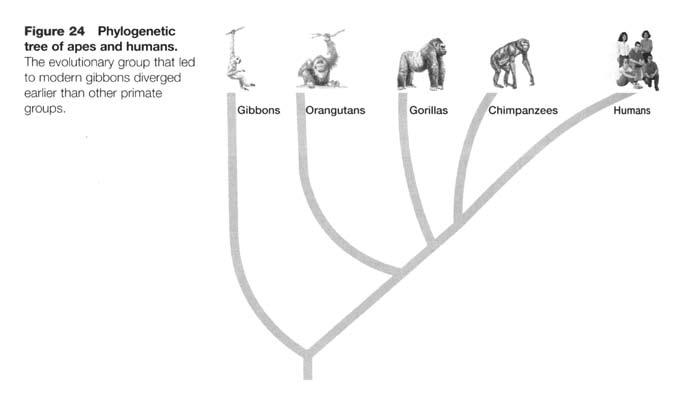
(Holt 732) Many evolutionists complain when people say that humans descended from monkeys. If the common ancestor for chimpanzees and humans shown in this phylogenetic tree did not look like a monkey, what did it look like?
The moral implications of the evolutionary philosophy that man is simply an advanced ape are increasingly manifested in our culture. If man is an ape, then the apelike or “primal” urges that we have for violence and sexuality can be excused as coming from our evolutionary history. Exercising those urges is contrary to the Christian doctrine of self-control. Many evolutionists try to separate biological evolution from evolutionary-based social philosophies on the grounds that those philosophies are not scientific. While this is true, evolutionists still try to deal with questions of behavior and their origins.
Bioethics is the area that deals with the moral and ethical implications of scientific knowledge and the technology it produces. If society espouses evolutionary/materialistic beliefs, those beliefs have consequences. There is no absolute basis for morality in a materialistic belief system; right and wrong are determined by the individual and society. As society changes, the laws that govern a society also change. Accepting the view that humans are simply highly evolved apes and that man determines truth is directly contrary to the absolute authority of the Creator God of the Bible.

The social concept of relative morality is based on evolutionary doctrine. If man is a product of random, cosmic accidents, then man should be able to decide what is right and wrong (if right and wrong even exist in humanistic philosophy). The problem is that there is no basis for deciding what point of view is right or wrong if each person comes to a different conclusion. The Bible provides absolute truth and authority for making moral decisions.
Starting from the evolutionary bias that apes and humans are similar, some evolutionists have proposed that chimps should actually be reclassified in the genus Homo alongside humans. Taking this a step further, several groups are pushing for “human rights” for the apes. If they are truly that similar to us, why not grant them these rights? One reason is that the Bible makes a clear distinction between human life and the life of animals. We are to be stewards of the earth and have dominion over the animals, but we are created in the image of God, which makes us distinct from the apes.
An examination of the fossils that are proposed as human ancestors, or at least along the branch that led to humans, shows many specimens that overlap in evolutionary time, as well as gaps of millions of years. There is no consensus on the path to humans, and any representation of the lineage is highly subjective. In the biblical creationist model, these specimens either represent some type of extinct ape, or groups of humans.
One of the unfortunate elements of the acceptance of the evolutionary origins of man was a marked increase in racial prejudice. Although racism certainly existed before the 1850s, evolution gave white Europeans a “scientific” justification to dominate the “less evolved” Africans and Australian Aborigines. Australian Aborigines were actually killed and taken to London as museum specimens of the “missing link” between apemen and modern humans. A pygmy by the name of Ota Benga was placed on exhibit in the monkey house at the Bronx Zoo. What could justify such treatment of humans? Evolution was used to justify the display because the Africans, Aborigines, and Mongols (Asians) were arbitrarily considered inferior races to the Caucasians of Europe. In contrast, the Bible explains that all men are created in the image of God (Genesis 1:26–27) and are of one blood (Acts 17:26)—there are no inferior races. In fact, there is only one race, the human race.
Humans are humans and have been so since the beginning; no prehistoric hominids ever evolved into humans. Though the fossil record is incomplete, it can only be interpreted accurately if the presuppositions are true—that truth comes from God, who is the only eyewitness to all of the events of history.
10:1 Did humans really evolve from apelike creatures? Menton,
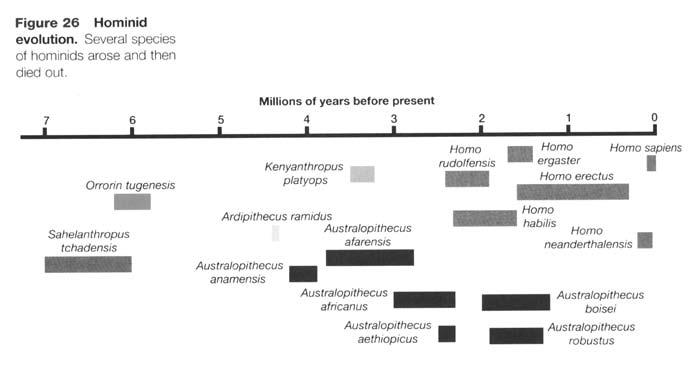
(Holt 734) Many textbooks have avoided including a tree of human evolution because the interpretation of fossil hominids changes constantly. This set of overlapping bars is actually a more accurate picture of the existence of distinct groups that have existed in the past. The time scale used directly contradicts the Bible, and many of the distinct groups are likely members of a single genus that has been artificially split based on evolutionary assumptions.
Many popular magazines and television programs show evidence purportedly proving that humans evolved from an apelike ancestor. Is the evidence real, or are they making apes out of men and men out of apes? Starting from biblical assumptions, we see clearly that God made man in His image and did not use evolution. Some Christians who accept evolution say that man’s soul was created by God, but evolution made the physical form. The evolutionary assumptions demand that man evolved from an apelike ancestor and discount biblical authority. Paleoanthropologists don’t ask if man evolved from apes, but which apes he evolved from.
The fossil evidence of hominids (alleged human ancestors) is extremely limited, and very few people actually get the fossils or pictures. And because jaws and teeth are the most commonly preserved primate fossils, these become a key part of the interpretations. The fraudulent Nebraska Man, including his family and livestock, was identified and drawn based on a single tooth, which was later found to be from an extinct pig.
Skull anatomy is also important, since brain capacity and facial features are used to demonstrate the supposed human-like features in some ape fossils. Leg and hip bones are important in demonstrating how the hominids walked. Those that walked upright are more human than those that didn’t.
To make an apelike human ancestor appear out of the fossil record, paleoanthropologists do one of three things. First, they combine pieces from an ape fossil and a human fossil and call it a hominid ancestor. This happened in the case of Piltdown man, which was identified as a hoax after being promoted as man’s ancestor for 50 years. The second way is to emphasize the ape features of a human fossil, such as oversized jaws, sloping foreheads, and other features that are found within the range of human variation. Finally, they emphasize the human features on an ape fossil. This is evident in the fossil “Lucy,” an Australopithecus afarensis specimen. Even though A. afarensis hips don’t support the idea that they walked upright and the foot bones are curved like an ape’s, it is usually shown standing with human feet—a blatant misrepresentation of the fossil evidence.
10:2 Australia’s Aborigines … did they see dinosaurs? Driver, https://answersingenesis.org/dinosaurs/humans/australias-aborigines-did-they-see-dinosaurs/
Stories of large creatures have been present in modern cultures around the world. Some of the most popular include Mokele-Mbembe and the Loch Ness Monster. While evolutionists must dismiss all of these claims as absurd because dinosaurs have been extinct for 65 million years, there is no reason to doubt that some species of dinosaurs could have survived the 4,500 years since the Flood. Credible accounts of the “bunyip,” “burrunjor,” and “kulta” among Aborigines seem to fit descriptions of “prehistoric” dinosaur-like creatures that could have survived in remote regions. The evidence of human and dinosaur coexistence includes cave paintings that apparently depict dinosaurs, the mention of dragons and behemoth in the Bible, and the presence of many dinosaur and dragon descriptions and pictures in Europe and Asia.
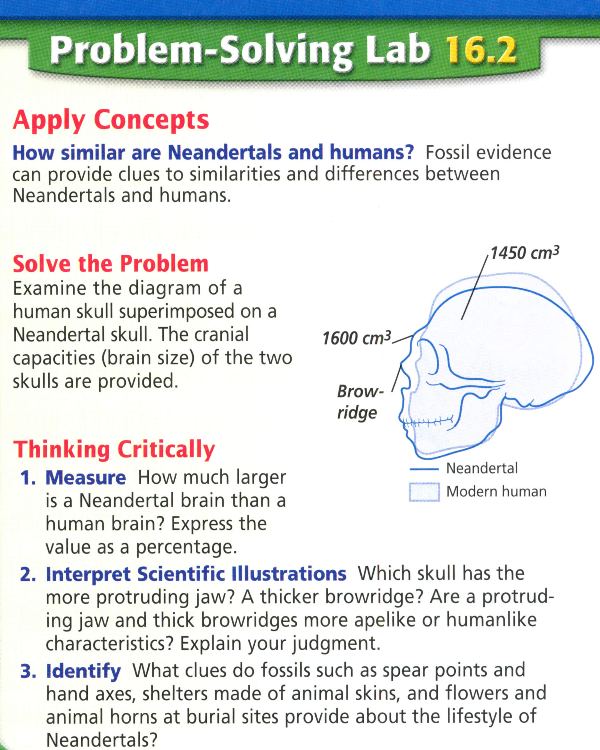
(Glencoe 433) In this activity, the features that are more apelike are emphasized to distinguish modern human skulls from Neanderthals. Despite the larger brain capacity and the features that can be found in the modern-day human population, Neanderthals are demoted to a subhuman category. Many scientists are beginning to reexamine the Neanderthal evidence and are using disease and diet to explain some of the skeletal differences seen.
10:3 Human Beings, Parker, www.answersingenesis.org/human-evolution/ape-man/human-beings-fossil-evidence/
Humans are the result of either a cosmic accident orchestrated by time and chance or the special creative act of God. Evolutionists once viewed Neanderthals as dumb, cave-dwelling brutes that were less than human, but creationists have always argued that they were fully human. Neanderthals lived in very harsh conditions where disease and nutrition may have produced some of the skeletal features seen, and many evolutionists are beginning to accept the creationist view of Neanderthals as an extinct human people group—not a missing link.
Tragically, other human people groups have been considered missing links and treated in barbaric ways. African Negroes and Australian Aborigines were sometimes considered less evolved humans. A century ago, Darwin’s idea encouraged the slaughter of Aborigines, and some were even prepared as museum specimens. It also gave credence to Hitler’s plan to exterminate the “inferior” Jewish race.
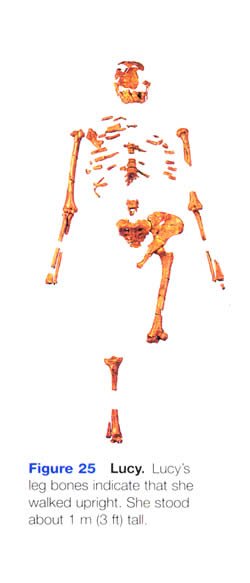
(Holt 733) “Despite the claim that australopithecines like Lucy walked upright, the data does not support the claim. Other apes living today have similar leg structures and do not walk upright.”
Piltdown man was thought to be a missing link for over 50 years before it was discovered to be a fraudulent combination of a human skull and an orangutan jaw. But because people wanted to believe evolution, they initially accepted the evidence without scientific scrutiny. The many different and dubious interpretations of Java man and Peking man (well documented in Bones of Contention by Martin Lubenow) are further evidence that people see what they believe in the fossils. Nebraska man was a hallmark in the Scopes Trial, but the tooth that inspired this image was later determined to be from an extinct pig.
There is no need to look for missing links if man is classified as a monkey, as a 1993 display at the Australian National Museum depicted: the common behaviors in humans and various apes were set forward as evidence for the claim. Australopithecus, the genus of the infamous “Lucy” specimen, is one of the most cited examples of a missing link in human evolution. The problem is that australopithecine features are all apelike, despite the claim that they walked upright. Many depictions actually show human hands and feet when the evidence clearly indicates curved, apelike features.
The fact that tools are found with some australopithecine fossils and that human fossils are found in strata directly underneath suggests that the tools may have been used on the apes, not by them. The extinct ape fossils may share characteristics with modern humans, but so do living apes. No evidence from the fossil record directly supports a transitional series from ape to human. Virtually every major discovery is later reinterpreted to fit a new version of evolution. People have always been people and apes have always been apes. Each was created according to the purpose and plan of God.
10:4 Chimp-human hybridization: two of a kind or two different kinds? DeWitt, https://answersingenesis.org/are-humans-animals/chimp-human-hybridization-two-of-a-kind-or-two-different-kinds/
In a complicated twisting of the evolutionary history of humans and chimps, a group of scientists studying hominoid DNA sequences has proposed a radical chain of events. Nick Patterson and his colleagues make the suggestion that chimps and humans began to diverge about 10 million years ago. Then, about 6 million years ago, they believe the two distinct populations merged to form a group of hybrids. They believe that fertile hybrid females then crossed back to one of the ancestral species, subsequently giving rise to distinct human and chimpanzee species. This extreme view is based on the fact that different regions of DNA sequence give different dates for divergence. There are also regions of the DNA where humans are closer to gorillas than humans and chimps. Instead of questioning the validity of the dating techniques, a contorted explanation is developed. The explanation of the data demonstrates the plastic nature of the evolutionary models. The differences are not expected in the Darwinian interpretation, but they fit the idea that each kind was created to be unique. Man and apes should not be considered to be closely related—as the data clearly suggests.
10:5 Chimp genome sequence very different from man, DeWitt, www.answersingenesis.org/go/dna-chimp
Evolutionists have claimed that chimp and human DNA is up to 99% similar. These studies only looked at gene coding regions, which are a tiny fraction of the 3 billion base pairs in the human genome. When the chimp genome was sequenced, the number was reduced to 96%, twice as much difference as was previously thought. No matter what the difference, evolution would predict it, and evolutionists would claim it as proof. It is estimated that 40 million mutation events would be required to produce 125 million differences in the DNA sequences. There’s not enough time in the evolutionary explanation for this to happen (Haldane’s Dilemma), and no new information is generated in these types of mutations anyway.
Some scientists are surprised at the anatomical, physical, and behavioral differences between man and chimpanzee when they see so much apparent genetic similarity. With a philosophy that excludes a Creator God, they are forced to accept similarity as evidence of common ancestry. However, similarity can also be the result of a common Designer. The differences make the difference, and the most important difference is that man is created in the image of God.
10:6 Neandertal Man—the changing picture, Oard, https://answersingenesis.org/human-evolution/neanderthal/neandertal-man-the-changing-picture/
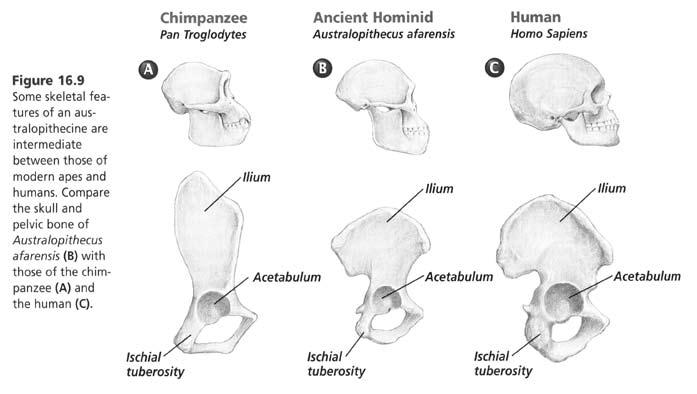
(Glencoe 430) The idea that skeletal features of australopithecines are intermediate to humans and chimpanzees is an interpretation that comes from the assumption that chimps and humans have a common ancestor. Starting from a different assumption, that humans and chimps have a common Designer, the evidence points to a Creator using similar structures to perform similar functions.
Neanderthals are often portrayed as unintelligent cavemen in animal-skin clothing. Neanderthals were first thought to be subhuman, but that thought is beginning to change. In the creationist view, Neanderthals and Cro-Magnons were post-Flood people groups that resulted after the dispersion from Babel. Neanderthals were originally given the name Homo neanderthalensis and considered an ancestor to modern humans. Fortyfour years after this biased classification, Neanderthals were reclassified as a human subspecies Homo sapiens neanderthalensis and described as nearly human. It has been claimed that they were unintelligent even though their brain capacity was larger than modern humans, and interpretations of their social habits vary from hunter to vegetarian.
Neanderthals present a challenge to Christians who believe that soulless humans came before Adam. There is conclusive evidence that Neanderthals and humans lived at the same time. Recent discoveries of a humanlike hyoid bone, burial practices, musical instruments, weapons, and other signs of culture have started to shift the picture in even the evolutionists’ minds. Evidence of hybridization between humans and Neanderthals, DNA comparisons, and the indications that they lived together for 100,000 years of evolutionary time point to the fact that they were fully human. This evidence contradicts evolutionary assumptions and supports the biblical position that Neanderthals simply represent some of the variety that was programmed into the human genome by our Creator.
Questions to Consider
- Since a species is commonly defined as a group that can interbreed, it seems that fossils could never be identified to the species level because we can’t observe how they interbreed. How do scientists determine what species a fossil is if it looks similar to another fossil but is a different size or slightly different shape? When scientists disagree with the classification of a fossil, who decides where it belongs?
- Since bananas share about 50% of their DNA with humans, does that mean bananas are half human?
- Does the suggestion that chimpanzee and human DNA are similar necessarily mean that they had a common ancestor? Could it also be considered evidence for a common designer?
- Since the human-chimp DNA comparisons are only based on a comparison of part of the genomes, how can it be claimed that they are 96% similar?
- Are there any alternative scientific explanations for humans evolving from apelike creatures?
- How do paleontologists know that certain apelike creatures were evolutionary dead ends and others led to a new species? Are there multiple ways to interpret the evidence? How do we know which to trust?
- If it is inaccurate to say that humans evolved from apes, but instead we should say all apes and humans have a common ancestor, what did the ancestor look like if not like an ape?
- Scientists often deal with bioethical issues (cloning, genetically modified foods, drugs, etc.). If man has evolved from apes, what is the moral basis for deciding what is right and wrong? If cultures determine what is right, how can we claim that other cultures’ views are wrong? If terrorists act within their beliefs and Nazis believe they are superior, can we say that they are wrong? Would Nazi ideology be right if it was accepted by a majority of cultures?
- Why has the picture of human evolution become less clear as more and more fossils have been found? It would seem that the picture would become clearer with more information.
- When we look at a car or an airplane, it is only logical to suggest that it was designed with the features that it has. The human body is much more intricate and complex than the most complex machines we can design. Why is it considered illogical to consider that the human body has a designer?
Tools for Digging Deeper
(see a complete list in the Introduction)
The New Answers Book by Ham, et al.
Buried Alive by Jack Cuozzo
Creation: Facts of Life by Gary Parker
The Fossil Book by Gary Parker
War of the Worldviews/i> by Ham, et al.
Evolution Exposed: Biology
This book helps teens discern the chronic bias towards belief in evolution that permeates today’s three most popular high school biology textbooks.
Read Online Buy BookRecommended Resources

Answers in Genesis is an apologetics ministry, dedicated to helping Christians defend their faith and proclaim the good news of Jesus Christ.
- Customer Service 800.778.3390
- © 2024 Answers in Genesis





